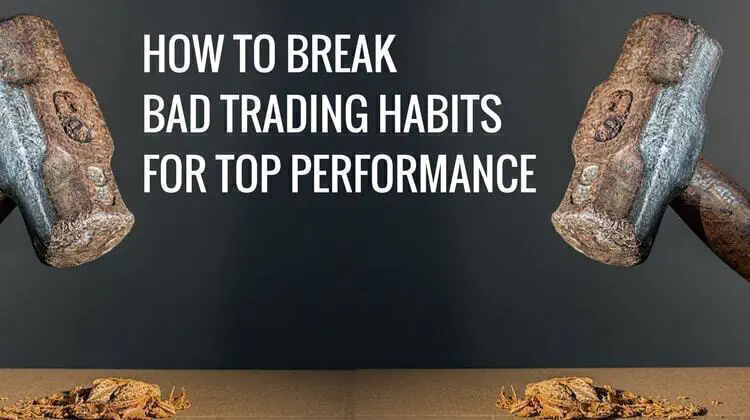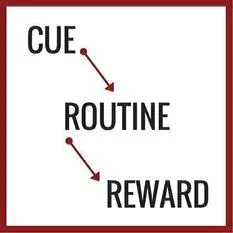How To Break Bad Trading Habits For Top Performance
By Galen Woods ‐ 7 min read
Bad trading habits affect your trading results. Improve your trading performance using a systematic way to overcome bad trading habits like overtrading.

As a trader, you don’t consciously respond to everything the market throws at you. As you gain experience, you form trading habits. And these habits have a significant impact on your trading results.
According to a study from Duke University, 45% of our behaviors are habitual. [link to paper] If this applies to your trading, it means that your trading habits explain 45% of your performance.
Hence, to trade better, you must cultivate good trading habits and eradicate bad ones.
You must have heard that you need to remain rational and control your emotions while trading. Focusing on correcting your habits is the best way to do so.
Why?
Your basal ganglia are responsible for your habits. And your prefrontal cortex handles complex decision-making, logic, and reasoning.
The problem is that our basal ganglia are stronger than our prefrontal cortex.
This means that your bad trading habits will overrule your rational trading decisions.
Now that you understand the importance of your trading habits, you can move on to tackling them.
What is a Trading Habit?
Before you can tackle any bad trading habits, you must first understand what a habit is.
According to Charles Duhiig in The Power of Habit, a habit is a cue-routine-reward loop.

An example of a bad trading habit is overtrading.
- Cue: The market moves up with considerable volatility.
- Routine: You click the “Buy” button on autopilot.
- Reward: You get a sense of euphoria - a mental high as you get a chance at winning money.
An example of a desirable trading habit is exercising patience in a dull market.
- Cue: The market is barely moving.
- Routine: You shut down the computer.
- Reward: You relish the free time you have as a perk of being a trader.
The Basic Template For Breaking Bad Trading Habits
This template has three steps:
- Identify your bad trading habits
- Break down the trading habit into its cue-routine-reward.
- Redirect the craving for the reward towards another routine.
Step 1: Identify your poor trading habits
The first step is to identify your bad trading habits. Some common ones are:
- Overtrading
- Revenge trading
- Not following your trading rules
- Placing illogical stop-losses
Self-serving bias might obscure your thinking process here. This bias attributes good things in life to yourself and pushes the blame out to others. As this bias takes root, you become blind to your bad trading habits.
For instance, you blame the market for taking back your paper profits. And in doing so, you fail to recognize that you have a bad habit of entering the market without a clear exit plan.
One excellent way to counter the self-serving bias is to engage your trading mentor or buddy. Get them to point out your bad trading habits. Stay open and listen to them.
Step 2: Break it down into its cue-routine-reward.
Every trading habit has a different cue-routine-reward loop. It differs according to your mindset as well. So there are many possibilities here.
Let’s go through an example to show how you can dissect your own trading habits.
For instance, you have a habit of tightening your stop-loss to breakeven prematurely.
Why is this trading habit bad?
It causes you to be stopped out of profitable trades that come with some whipsaws. You are avoiding the temporary feeling of being a loser. But your long-term profitability suffers as you get stopped out prematurely.
Tightening your stop-loss is a response to the market moving against your position. You get rewarded with the feeling that you will not be a loser.
The habit loop for this particular trading habit is shown below.
- Cue: Adverse market movement
- Routine: Tighten stop-loss to breakeven
- Reward: Avoid the feeling of losing a trade
One final note to help you dissect your trading habits. In trading, very often, the reward for bad habits is not monetary or physical. It’s a rewarding feeling or emotion that your brain enjoys.
Step 3: Redirect your craving for the reward
Due to the reward you get by completing the habit loop, you develop a craving that reinforces the habit.
Hence, the key to combating lousy trading habits is to identify the craving and redirect it.
In this sense, breaking a bad habit means replacing it with a good one.
Let’s continue with the example above. But here, we will maintain the cue and the reward but swap out the routine.
- Cue: Adverse market movement
- Routine:
Tighten stop-loss to breakevenReview your reasons for taking the trade - Reward: Avoid feeling like a loser
You crave to avoid the feeling of a loser. Don’t resist the craving. Instead, think of a healthy method to get the reward you desire. And in this case, it’s to avoid feeling like a loser.
Reviewing your original reasons for taking the trade is a good replacement routine. It reminds you of the valid reasons you had for choosing to make this trade. In this game of probability, the outcome of a single trade is irrelevant. It’s the process that matters.
And since you have solid reasons to support this trade, you are already a winner and not a loser. It will reinforce your confidence in your position. It will also help you resist the temptation of meddling with it.
In practice, redirecting your craving is easier said than done.
A useful method here is to employ a pause.
Once you sense your craving, pause before reacting. This break in tempo is the best way to disrupt your automatic self or what Daniel Kahneman labels System 1.
Tips For Forming and Breaking Trading Habits
As you try to break your bad trading habits with the steps above, you will undoubtedly face difficulties.
Don’t give up. Use these helpful tips to help you stay on course.
Tip #1: Manage Stress and Emotions
Bad habits are resilient. In particular, both stress and repressed emotions cause bad habits to resurface.
Trading happens to be a stressful activity. And traders always take rides on the emotional rollercoaster. Hence, bad trading habits are exceptionally resilient.
This is why I always emphasize the importance of being well-capitalized for traders. If you are undercapitalized, financial stress is inevitable. Under such pressure, bad trading habits will stick and drag you down.
As for emotions, everyone has them. But repressing them does the most harm in the context of managing bad habits. Hence, make sure you find a way to express your feelings. Some popular methods include journaling, better communication, and meditation.
More ways to deal with repressed feelings here.
Tip #2: Build Self-Control With Mini Habits
Start small with mini habits. The aim of having mini habits is to use them to feel in control and build up willpower. They will help you with forming habits in general.
These mini habits need not be directly related to trading.
Clearing your trading desk before you start trading is an excellent mini habit.
Doing five push-ups and read your favorite trading quote aloud are good options too.
Tip #3: Focus On A Keystone Habit
For best results, work on a keystone habit.
A keystone trading habit is one that has trickle-down effects on your entire trading process.
An example of a keystone trading habit is to record your trades in detail. (Your reasons for taking each trade, screenshots, emotions, and outcome.)
Once you get into the habit of recording your trades, you are more likely think carefully about your reasons for taking each trade.
Also, with proper trading records, you are more likely to form a habit of reviewing your trading process systematically.
This is how focusing on one keystone trading habit helps to form other helpful trading habits.
Tip #4: Rely On Willpower Instead Of Motivation
When it comes to breaking bad trading habits, motivation is helpful. But it is not dependable as your motivation changes according to external circumstances.
Your willpower is more reliable than motivation. Willpower is a muscle that you can depend on once you train it up. Learn more about training up your willpower.
The good news is that as a habit becomes more established, you need less willpower to persist with it. In other words, it’s worth putting in the effort in the initial stage.
Further Resources To Help You Break Bad Trading Habits
This article included many concepts and tips from books that I wish I had read earlier. They would’ve clued me into a more systematic way to improve my trading behavior.
These are the books that are helpful for understanding the nature of habits. Mini Habits also has a course on Udemy if you’re interested - Mini Habit Mastery: The Scientific Way To Change Your Habits![]() .
.
Some apps to help you track and build your habits:
In the long run, your trading habits will make or break your trading performance. Start paying attention to your automatic self today.